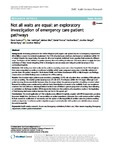Not all waits are equal: an exploratory investigation of emergency care patient pathways
| dc.contributor.author | Swancutt, D | |
| dc.contributor.author | Joel-Edgar, S | |
| dc.contributor.author | Allen, M | |
| dc.contributor.author | Thomas, D | |
| dc.contributor.author | Brant, H | |
| dc.contributor.author | Benger, J | |
| dc.contributor.author | Byng, R | |
| dc.contributor.author | Pinkney, J | |
| dc.date.accessioned | 2017-08-11T09:14:01Z | |
| dc.date.available | 2017-08-11T09:14:01Z | |
| dc.date.issued | 2017-12 | |
| dc.identifier.issn | 1472-6963 | |
| dc.identifier.issn | 1472-6963 | |
| dc.identifier.other | 436 | |
| dc.identifier.uri | http://hdl.handle.net/10026.1/9761 | |
| dc.description.abstract |
BACKGROUND: Increasing pressure in the United Kingdom (UK) urgent care system has led to Emergency Departments (EDs) failing to meet the national requirement that 95% of patients are admitted, discharged or transferred within 4-h of arrival. Despite the target being the same for all acute hospitals, individual Trusts organise their services in different ways. The impact of this variation on patient journey time and waiting is unknown. Our study aimed to apply the Lean technique of Value Stream Mapping (VSM) to investigate care processes and delays in patient journeys at four contrasting hospitals. METHODS: VSM timing data were collected for patients accessing acute care at four hospitals in South West England. Data were categorised according to waits and activities, which were compared across sites to identify variations in practice from the patient viewpoint. We included Public and Patient Involvement (PPI) to fully interpret our findings; observations and initial findings were considered in a PPI workshop. RESULTS: One hundred eight patients were recruited, comprising 25,432 min of patient time containing 4098 episodes of care or waiting. The median patient journey was 223 min (3 h, 43 min); just within the 4-h target. Although total patient journey times were similar between sites, the stage where the greatest proportion of waiting occurred varied. Reasons for waiting were dominated by waits for beds, investigations or results to be available. From our sample we observed that EDs without a discharge/clinical decision area exhibited a greater proportion of waiting time following an admission or discharge decision. PPI interpretation indicated that patients who experience waits at the beginning of their journey feel more anxious because they are 'not in the system yet'. CONCLUSIONS: The novel application of VSM analysis across different hospitals, coupled with PPI interpretation, provides important insight into the impact of care provision on patient experience. Measures that could reduce patient waiting include automatic notification of test results, and the option of discharge/clinical decision areas for patients awaiting results or departure. To enhance patient experience, good communication with patients and relatives about reasons for waits is essential. | |
| dc.format.extent | 0-0 | |
| dc.format.medium | Electronic | |
| dc.language | en | |
| dc.language.iso | en | |
| dc.publisher | Springer Science and Business Media LLC | |
| dc.subject | Health service research | |
| dc.subject | Acute care | |
| dc.subject | Emergency admissions | |
| dc.subject | Patient care | |
| dc.subject | Value stream mapping | |
| dc.subject | Emergency department | |
| dc.subject | Patient public involvement | |
| dc.title | Not all waits are equal: an exploratory investigation of emergency care patient pathways | |
| dc.type | journal-article | |
| dc.type | Article | |
| plymouth.author-url | https://www.ncbi.nlm.nih.gov/pubmed/28646876 | |
| plymouth.issue | 1 | |
| plymouth.volume | 17 | |
| plymouth.publication-status | Published | |
| plymouth.journal | BMC Health Services Research | |
| dc.identifier.doi | 10.1186/s12913-017-2349-2 | |
| plymouth.organisational-group | /Plymouth | |
| plymouth.organisational-group | /Plymouth/Faculty of Health | |
| plymouth.organisational-group | /Plymouth/Faculty of Health/Peninsula Medical School | |
| plymouth.organisational-group | /Plymouth/REF 2021 Researchers by UoA | |
| plymouth.organisational-group | /Plymouth/REF 2021 Researchers by UoA/UoA03 Allied Health Professions, Dentistry, Nursing and Pharmacy | |
| plymouth.organisational-group | /Plymouth/Research Groups | |
| plymouth.organisational-group | /Plymouth/Research Groups/FoH - Community and Primary Care | |
| plymouth.organisational-group | /Plymouth/Research Groups/Institute of Health and Community | |
| plymouth.organisational-group | /Plymouth/Research Groups/Institute of Translational and Stratified Medicine (ITSMED) | |
| plymouth.organisational-group | /Plymouth/Research Groups/Institute of Translational and Stratified Medicine (ITSMED)/CCT&PS | |
| plymouth.organisational-group | /Plymouth/Research Groups/Plymouth Institute of Health and Care Research (PIHR) | |
| plymouth.organisational-group | /Plymouth/Users by role | |
| plymouth.organisational-group | /Plymouth/Users by role/Academics | |
| dc.publisher.place | England | |
| dcterms.dateAccepted | 2017-06-01 | |
| dc.identifier.eissn | 1472-6963 | |
| dc.rights.embargoperiod | No embargo | |
| rioxxterms.versionofrecord | 10.1186/s12913-017-2349-2 | |
| rioxxterms.licenseref.uri | http://www.rioxx.net/licenses/all-rights-reserved | |
| rioxxterms.licenseref.startdate | 2017-12 | |
| rioxxterms.type | Journal Article/Review | |
| plymouth.funder | How can frontline expertise and new models of care best contribute to safely reducing avoidable acute admissions?::NIHR Evaluation Trials and Studies Coordinating Centre | |
| plymouth.oa-location | https://bmchealthservres.biomedcentral.com/articles/10.1186/s12913-017-2349-2 |


